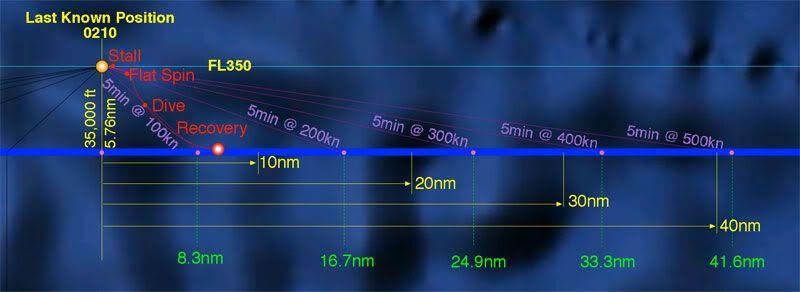The upset occurred within seconds of the ACARS position report at 0210 (02:10:10 - .1/WRN/WN0906010210 221002006AUTO FLT AP OFF). Minutes later, the aircraft reported that cabin pressure couldn't keep up with ambient (02:14:26 - .1/WRN/WN0906010214 213100206ADVISORY CABIN VERTICAL SPEED). Assume the aircraft was (and had been) falling fast. But not so fast as to exceed V-tears-itself-apart: impacted water intact at high vertical speed in line of flight.
In the earlier thread there was quite a bit of discussion about stalls and spins in an A330. Could a slow, flat spin have occurred after being upset and stalling at altitude? Could the pilot(s) have been working their way out of the spin with inventive ailerons and flaps, elevators and spoilers, getting the nose down and rotation stopped, airflow and nose-up AOA back, finally inching out of dive towards a level flight, degree by degree, deep into g forces. "Stand on the opposite rudder and then pump the elevator forward and hold it," my CFI explained from the right seat many years ago. I'm pretty sure this NASA Standard spin recovery procedure (
PARE) wouldn't work in rudder-limited Alt2 law... Don't know that control of AF447 was ever regained following the initial upset. Spin testing of commercial aircraft not part of the certification process nor part of training, as far as I know. Possibly a case of "unrecoverable spin mode" where "there is no guarantee that spin recovery can be effected beyond the first turn in a spin."
From the point of upset, and knowing/assuming the aircraft was in the water in less than five minutes, you can draw concentric circles showing the farthest the aircraft might have flown in a straight line at various averaged ground speeds. Thus in five minutes, the aircraft could have traveled as far as 24.9 nautical miles at an averaged ground speed of 300 knots. Could have traveled farther at a constant 400 knots. But forward travel not likely, with the aircraft out of control. See diagram.
More likely, all went bad and vertical very quickly. Shedding velocity and motion along the track, unusual attitudes, rapid descent (in a spin?), dark, stormy... Draw that circle maybe ten or fifteen nautical miles radius from the Last Known Position. BEA have not searched there yet.

GB